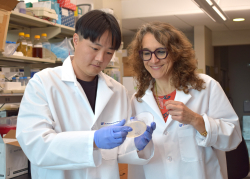 JUPITER, Fla. — In a discovery fundamental to the inner workings of cells, scientists have discovered that if oxidative stress damages protein factories called ribosomes, repair crews may move in to help fix the damage so work can quickly resume.
JUPITER, Fla. — In a discovery fundamental to the inner workings of cells, scientists have discovered that if oxidative stress damages protein factories called ribosomes, repair crews may move in to help fix the damage so work can quickly resume.
The discovery, reported Friday in the journal Molecular Cell, could have implications for cancer, the aging process, and growth and development, said the study’s lead author, molecular biologist Katrin Karbstein, Ph.D., a professor at The Herbert Wertheim UF Scripps Institute for Biomedical Innovation & Technology.
“Literally more than half the mass of all cells are ribosomes,” Karbstein said. “If you don’t have enough ribosomes, or they are malfunctioning, proteins aren’t made correctly, and that can lead to all these diseases. We know that defects in the machinery of ribosomes are found in all cancer cells, for example.”
In humans, an individual cell may have 10 million ribosomes whirring away, assembling the proteins spelled out in genes, one amino acid at a time. While many things can damage them — infections, ultraviolet light, radiation or oxidative stress — cells have a remarkable ability to protect themselves. Often, the damaged items are tagged for destruction, cut up and recycled. However, because ribosomes are so important to have in large numbers, destroying every damaged ribosome is problematic.
In a study of yeast cells, Karbstein and colleagues found ribosomes have an alternative response to oxidative stress damage. Oxidative stress occurs in cells when highly reactive oxygen molecules produced by the energy metabolism process must find stable places to land. Often those stable places reside within proteins. The introduction of the excess oxygen can change and damage proteins.

“Typically when proteins are broken, the cell just degrades them. The ribosome is a very large complex of RNAs and proteins, so maybe if a section gets broken you don’t want to throw out the whole thing,” Karbstein said. “It is like changing a flat tire, rather than buying a new car.”
Other study authors include first author Yoon-Mo (Jason) Yang, Ph.D.; Kate Carroll, Ph.D.; and Youngeun Jung, Ph.D., also of The Wertheim UF Scripps Institute, plus Daniel Abegg, Ph.D., and Alexander Adibekian, Ph.D., now of the University of Chicago.
This work was supported by National Institutes of Health grant R01GM145886 (AA), F32-GM139302 (YY), R35-GM136323 (KK), R01GM102187 (KSC) and HHMI Faculty Scholar grant 55108536 (KK).

